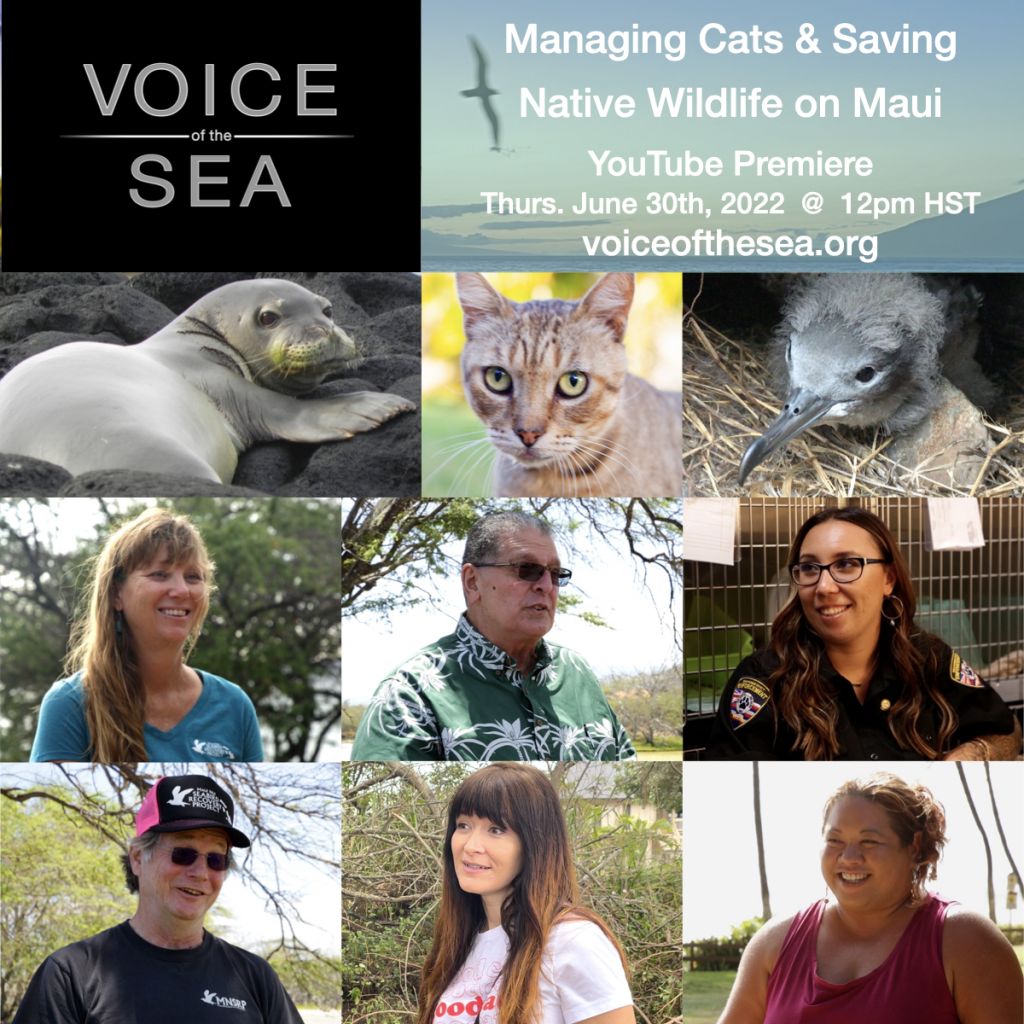Managing Cats & Saving Native Wildlife on Maui
We’re on Maui, learning about efforts to manage the extreme number of feral cats—and how that will benefit both cats and the ecosystem! Cats in the wild have relatively harsh, short lives. And, they spread disease, posing health threats to birds, marine mammals, and humans. Cats also prey on native birds—from the nearshore wetlands to the high forests—killing critically endangered native species and disrupting the ecosystem.
Across Maui Nui, experts are working to innovatively solve the problem of too many cats. We talk to Mayor Michael Victorino; Jay Penniman and Jenni Learned from the Maui Nui Seabird Recovery Project; Emily Drose from the Maui Humane Society; Darlene Rayhill from the Good Cat Network; and Kehau Kimokeo from the Division of Aquatic Resources—all working to restore the resilience of Maui’s environment by reducing the number of feral cats, rebuilding native bird populations, and supporting the recovery of endangered marine mammals.
Watch the trailer for Season 9, Episode 4 on Vimeo, on YouTube, or on Vimeo with English Subtitles.
Watch the related episode Monk Seals and Toxoplasmosis, Season 9, Episode 5.
Full Episode
Curriculum Connections:

Seabirds
- Maui Nui Seabird Recovery Project:
- Oʻahu Seabird Group: Learn About Seabirds
- Exploring Our Fluid Earth Grades 6-12: Birds
- Activity: Local Bird Guide
- NOAA National Marine Sanctuaries
- Oikonos Ecosystem Knowledge: Winged Ambassadors
- Activity book: Seabirds & Shorebirds of Hawaiʻi
- Hawaiʻi Audobon Society ʻUaʻu Kani “Way of the Wedgie: Survival Lessons from a Seabird Perspective“
- NOAA Fisheries Pacific Remote Island Marine National Monument: Seabird Biology Case Studies
Hawaiian Monk Seals
- National Marine Sanctuaries—Tails and Tales: Hawaiian Monk Seal
- Mālama Learning Center: Hawaiian Monk Seals
- NOAA Fisheries: Hawaiian Monk Seals and Toxoplasmosis
- Centers for Disease Control and Prevention: Toxoplasmosis
Additional Resources:
- Maui County
- Website
- Office of Climate Change, Resiliency, and Sustainability
- Watch Maui County’s YouTube Channel
- Follow Maui County on Facebook, Instagram @countyofmaui, or Twitter @CountyofMaui
- Maui Nui Seabird Recovery Project
- Website
- ʻUaʻu (Hawaiian Petrel) / DLNR ʻUaʻu page
- ʻUaʻu Kani (Wedge-Tailed Shearwater) / DLNR ʻUaʻu Kani page
- Follow Maui Nui Seabird Recovery Project on Facebook, Instagram @maui_nui_seabirds, or Twitter @Mauinui_Seabird
- Maui Humane Society
- Website
- Spay and Neuter Services
- Managing Community Cats
- Report an Incident
- Volunteer
- Hawaiʻi News Now: Maui Humane Society urges residents to stop ‘trapping and dumping’ cats
- Maui News: Illegal trapping, transporting of pet cats a widespread problem
- Follow Maui Humane Society on Facebook, Instagram @mauihumanesociety, or Twitter @mauihumane
- Good Cat Network
- Website
- Hawaii Public Radio: Operation Aloha Cat flies kittens to the mainland for adoption
- Hawaiʻi News Now: With Maui overrun with stray cats, group finds home for felines on the mainland
- Follow the Good Cat Network on Facebook or Instagram @goodcatnetwork
- Hawaiʻi Department of Land and Natural Resources (DLNR): Division of Aquatic Resources
- Website
- Kanahā Pond Wildlife Sanctuary
- Invasive Predators
- Cats: DLNR information / Maui Forest Bird Bird Recovery Project Cat Fact Page
- Indian Mongoose: DLNR information / Maui Forest Bird Bird Recovery Project Mongoose Fact Page
- Rats: DLNR information / Maui Forest Bird Bird Recovery Project Rat Fact Page
- Ungulates: Maui Forest Bird Bird Recovery Project Fact Page
Reducing feral cat numbers, and protecting and restoring native populations of birds and marine mammals, requires input and action across our communities. You can help by being a responsible neighbor:
- Get your cat spayed or neutered.
- Keep your cat indoors when possible (especially at night when birds are more susceptible).
- Bring or report stray cats to the humane society.
- Do not dump unwanted cats or other pets into the wild.
- Do not feed feral cats.
- Volunteer to help with
- fencing and trapping of cats and mongoose,
- counting birds and restoring native plant habitat,
- fostering cats for adoption, or
- monitoring cat colonies.
Select a season of Voice of the Sea
Contact information:
Kanesa Seraphin, Ph.D.
kanesa@hawaii.edu
CONNECT



